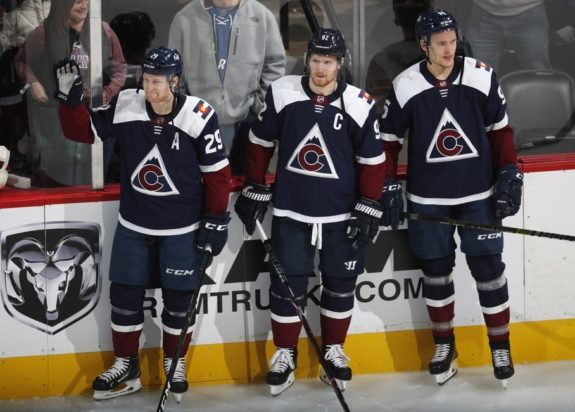It’s early to discuss Nathan MacKinnon’s next contract (he’s not due for an extension until the 2023-24 season) but the ramifications of what should be an enormous deal dictates how the Colorado Avalanche move forward into the back-half of the 2020s. The superstar center will still only be 28 when his next contract takes effect, meaning he likely continues to produce at an all-NHL level for the majority of the upcoming commitment. With several years atop the scoring leaderboard under his belt, MacKinnon can use the salaries paid to other NHL superstars as tangible benchmarks. Using statistical analysis and historical comparables at the center position, I project the deal that locks up the seventh-highest scorer in franchise history through the rest of his prime. Let’s dig in.
MacKinnon’s Contract Promise
Before embarking on any attempts at a contract projection, some important context must be established around MacKinnon’s outlook. With the backdrop of rabid discourse surrounding the enormous contracts awarded to Toronto Maple Leafs’ young stars, the Halifax-born center was asked for his thoughts on his extremely team-friendly deal, and what he valued as it pertained to his next contract. MacKinnon indicated that he would take a pay cut to allow the Avalanche to continue building a Stanley Cup-caliber roster around him in the future. While admirable, his remarks were tinged by half-truths that, when examined critically, don’t hold up to scrutiny. This isn’t meant to needle MacKinnon, but much of the public discourse fails to adequately explain how Colorado developed into perennial contenders.
Before signing his current seven-year, $44-million deal in the summer of 2016, MacKinnon had only scored at a 57-point pace through his first three NHL seasons. After another slightly underwhelming season in which he tallied just 53 points in 82 games, the Avalanche superstar exploded in 2017-18 by scoring 97 points in 74 games, earning a Hart Trophy nomination and a place on the NHL’s Second All-Star Team in the process. Since that fateful season, he has delivered on his prestigious draft pedigree, ranking third in the NHL in total points scored during that time — production worthy of a contract similar to those enjoyed by the league’s other elite offensive talents.

It’s difficult to parse exactly what sort of discount MacKinnon considers to be “less,” but it’s doubtful that he leaves significant money on the table after being woefully underpaid for the majority of his career. His career arc is eerily similar to that of NBA superstar Stephen Curry — high draft picks experiencing stunted development before reaching another level while on a sweetheart deal — suggesting Colorado’s current situation is more a product of circumstance than the result of prophetic foresight. Not to dismiss the organization’s tendency to collect undervalued players that accentuate the roster’s strengths, but MacKinnon took an easy win with his comments. There’s nothing wrong with his approach, but time will tell if he keeps his word. Now, let’s look at how MacKinnon stacks up to the NHL’s best, prime-age centers.
Comparing MacKinnon to Positional Peers
Highly talented centers are the most valued assets in the NHL due to the tremendous responsibilities of offensive production and defensive reliability that are packaged with the job description. If a player embodies the gold standard of the position, they can expect to be paid handsomely. MacKinnon’s eye-popping production positions him as an All-NHL talent, and entitles him to the corresponding wage bracket. By comparing his statistical profile to that of his positional peers and age-cohort (consider this a pre-emptive apology for excluding Sidney Crosby and Evgeni Malkin in the latter half of this exercise), a relatively accurate contract projection can be generated for the Avalanche superstar.
Historical Contract Comparisons
Firstly, strictly comparing contracts through the lens of their total cap hit ignores the financial realities of the environment in which it was signed. For example, when Crosby inked his 12-year, $104.4 million contract in the summer of 2012, the ceiling of the NHL’s salary cap was $60 million. His deal looks much more favourable in 2021, but it was the richest contract of the salary cap era by the percentage of the cap it occupied at the time it was signed. It’s also illegal, grandfathered in after the consummation of the most recent Collective Bargaining Agreement, which limits contract length to eight years. Consequently, a deal’s cap hit percentage is a more useful tool for projecting future contracts.
| Player | Age Signed | Years | AAV (In millions) | Cap Hit % |
|---|---|---|---|---|
| Connor McDavid | 20 | 8 | $12.5 | 16.7 |
| Jonathan Toews | 26 | 8 | $10.5 | 15.2 |
| Evgeni Malkin | 26 | 8 | $9.5 | 14.8 |
| Auston Matthews | 21 | 5 | $11.64 | 14.6 |
| Sidney Crosby | 24 | 12 | $8.7 | 14.5 |
Connor McDavid and Auston Matthews are two examples of young superstars bucking the trend of signing cheaper, team-friendly bridge deals, which depress their earnings through their prime years of production. Analytical research indicates that a forward’s age 24-26 seasons represents their offensive peak, but that’s when players have historically signed what is considered their career defining contract as an unrestricted free agent (UFA). Arguments can be made that it is unwise to hand gigantic deals to unproven commodities, but the era of greater player empowerment is here.
Of the five centers shown on that table, Malkin and Jonathan Toews best exemplify MacKinnon’s current age profile when signing a contract thhat buys several expensive years of a player’s UFA eligibility. It should be noted that at the time of signing his contact, Toews had already won a pair of Stanley Cups. However, the longtime Chicago Blackhawks’ captain had only once eclipsed a point-per-game pace before inking his extension. On the other hand, Malkin’s early career portfolio could quite possibly be the most impressive in NHL history. The Russian pivot scored 100 points three times, won a Hart Trophy, two Art Ross honours, and was awarded the Conn Smythe for his excellence in Pittsburgh’s 2009 Stanley Cup triumph, all before the age of 25. As you’ll see, MacKinnon is positioned between the two, surpassing Toews’ offensive production, but lacking the individual or team hardware boasted by both of his contemporaries.
Related: Colorado Avalanche 2021-22 Season Preview Section
If MacKinnon commands a similar slice of the cap — say, 15 percent — an eight-year deal that takes him through his age-34 season would assume an average annual value (AAV) of $12.2 million under the current $81.5 million limit. Keep that in mind as we analyze the Avalanche frontman’s peers in the under-30 age bracket.
Comparing Statistical Profiles – Offensive Production
Statistics provide tangible, objective evidence that is free from bias and allows for direct comparisons between players, allowing us to determine whether MacKinnon as a legitimate case for demanding a contract worth north of $10 million. The traditional boxscore statistics (goals, assists, points) often comprise the majority of a player’s argument in negotiations, and MacKinnon matches up favourably with his fellow centers.
| Player | G/GP | A/GP | PTS/GP |
|---|---|---|---|
| Connor McDavid | 0.55 (5) | 1.06 (1) | 1.61 (1) |
| Auston Matthews | 0.66 (1) | 0.49 (46) | 1.15 (12) |
| Nathan MacKinnon | 0.48 (9) | 0.81 (6) | 1.29 (4) |
| Leon Draisaitl | 0.59 (3) | 0.84 (5) | 1.43 (2) |
| Aleksander Barkov | 0.41 (22) | 0.68 (14) | 1.09 (16) |
The Avalanche superstar is one of the league’s most versatile attacking threats, ranking within the top-10 in both his goal-scoring and assist-creating rates per game over the past three seasons — one of a select few to accomplish that feat. Over that time span, he also leads the NHL in terms of the volume and pace at which he generates shots on goal, comfortable in testing goaltenders from any range with his laser-like wrist shot. His propensity to shoot from anywhere hurts his overall shooting percentage, but he more than makes up for it through sheer quantity alone.
Evaluating a player’s production at 5-on-5 offers a more representative sample of a player’s ability to function without the numerical advantage inherent to power play situations. MacKinnon maintains his elite scoring rate even when isolating his even-strength performance, finding himself in fifth in total even-strength points since 2018-19 — third among centers — behind only Edmonton’s dynamic duo on the leaderboard. He rarely relies on secondary assists to pad his scoring totals either, accruing primary assists at the sixth-highest rate (1.14-per-60) at 5-on-5 since 2018. Just like other offensive stars, MacKinnon benefits from the generous ice time afforded to players of his ilk, but succeeds in spite of the increased attention from defenses and the raised expectations accompanying that privilege.

(AP Photo/David Zalubowski)
Even as I harp on the importance of considering disparities in ice time and deployment, the power play is an important component of any given hockey game, with goals scored on the man-advantage accounting for nearly 20 percent of the NHL’s cumulative offensive output last season. MacKinnon is just as lethal on the power play, leveraging more open ice and the threat posed by his teammates to march into dangerous scoring areas and create offense. His per-60 rates for goals (2.36) and primary assists (2.14) both land in the top-30 league-wide since 2018, and MacKinnon has produced at the 10th-highest clip in terms of points-per-60 on the power play among all NHL forwards, beating out Matthews and Aleksander Barkov across the three-year period.
In any case, MacKinnon has more than paid his dues. He ranks sixth in goals-per-game (0.49), and third in both assists- (0.8) and points-per-game (1.3) among all NHL skaters since his breakout 2017-18 campaign. Further, his postseason success, although minimal, exceeds that of any of his four comparables, reaching the second round of the playoffs in three consecutive seasons while posting the third-highest point-scoring rate (1.37) since 2018. Of the four, only McDavid and Leon Draisaitl have advanced past the first round, but have failed to do so since 2017. Very few NHL forwards can hold a candle to MacKinnon’s level of production, solidifying his case for a gargantuan contract come the 2023 offseason.
The Trophy Case – NHL Awards and Honours
Fairly or not, year-end trophies give players evidence to point to that demonstrate their excellence compared to their peers, tangibly boosting their case for a more lucrative contract. Fortunately for the Avalanche, MacKinnon plays at the same time as McDavid, severely restricting his ability to accumulate individual hardware. It’s difficult to compete with someone who was on track to eclipse 150 points in a full 82-game season, or best an Auston Matthews who torched the North Division with 41 goals in 52 games — the first 60-goal trajectory since Steven Stamkos in 2011-12. Colorado’s offensive figurehead narrowly lost out on the 2017-18 Hart Trophy, potentially his best opportunity to win the award before McDavid and Matthews entered their respective primes.
| Player | Hart | “Rocket” Richard | Art Ross | Selke | 1st/2nd All-Star Team |
|---|---|---|---|---|---|
| Connor McDavid | X | X | X | ||
| Auston Matthews | X | X | |||
| Nathan MacKinnon | X | ||||
| Leon Draisaitl | X | X | X | ||
| Aleksander Barkov | X |
However, the Avalanche enter the 2021-22 as prohibitive Stanley Cup favourites, boasting an enviable array of offensive weapons with which to flank MacKinnon. Continuing to roam the same ice as Mikko Rantanen (fifth in goals in 2020-21) and Cale Makar (first in points-per-game among defensemen) significantly increases the probability that MacKinnon approaches McDavid’s astronomical rate of scoring. Greater production coupled with another dominant regular season by the Avalanche makes a sturdy case for end-of-year hardware, better equipping MacKinnon for future contract discussions. After exploring the Avalanche star’s statistical argument and trophy case, it’s time to project the details of his future contract.
Projecting MacKinnon’s Next Contract
Unless MacKinnon wins multiple individual honours or leads the Avalanche to a Stanley Cup, he doesn’t have much of a case for garnering a contract worth more annually than McDavid’s, capping his future deal at a $12.5 million AAV ceiling. However, he can claim being underpaid through his prime warrants a record-shattering agreement, especially as the NHL projects the cap to rise halfway through a potential MacKinnon extension. For reference, consider the contract commitments carried by the aforementioned NHL centers:
| Player | Age Signed | Years | AAV (In millions) | Cap Hit % |
|---|---|---|---|---|
| Connor McDavid | 20 | 8 | $12.5 | 16.7 |
| Auston Matthews | 21 | 5 | $11.64 | 14.6 |
| Aleksander Barkov | 26 | 8 | $10 | 12.3 |
| Leon Draisaitl | 21 | 8 | $8.5 | 11.3 |
The contracts awarded to other top NHL centers sets a clear precedent for the floor and ceiling of MacKinnon’s next contract. A floor of 11.3 percent of the cap suggests an AAV of at least $9.2 million, while a ceiling of 16.7 percent takes him beyond McDavid’s raw total in the form of a deal worth $13.6 million per year. Draisaitl signed a similar contract to MacKinnon, his price slightly reduced after struggling to start his NHL career. Seeing as he’s clearly blossomed into a tremendous offensive force, it’s safe to throw out his deal as a legitimate comparable. Otherwise, crafting a compelling case for exceeding the cap hit of Edmonton’s captain proves difficult, meaning that we’ll have to settle for something in the middle.
His combination of regular-season excellence and strong playoff performances suggests he’ll command a cap hit closer to the 14-15 percent range. This approaches the contracts for Toews and Malkin, which were signed at points in the pair’s careers that more closely resembles MacKinnon’s age profile when his current deal is set to expire. As I calculated earlier, a 15 percent cut of a $81.5 million salary pie gives him an AAV of $12.2 million, an annual payout which exceeds those enjoyed by Barkov and Matthews, but still falls short of McDavid’s high-water mark.

The relatively young age of MacKinnon’s current positional comparables at the time of signing their contracts means it’s difficult to draw a direct link between what they are owed and what he can expect to command on his next deal. Given the statistical portfolio that MacKinnon can present to Avalanche management, such a contract toes the line between deserved and incredulous, as it’s unlikely that anyone eclipses McDavid’s deal until the salary cap returns to pre-pandemic levels.
Can the Avalanche Afford MacKinnon’s Next Contract?
While retaining MacKinnon is only a matter of time, the financial precariousness brought upon by the COVID-19 pandemic could force the Avalanche roster to undergo a significant transformation as a result. In a recent press conference, NHL commissioner Gary Bettman suggested that the salary cap stagnates in the immediate future as the league gradually recovers from lost revenues.
Two seasons is an eternity in sports, but potential Bowen Byram and Alex Newhook extensions loom on the horizon, and decisions on the eventual re-signing of integral supporting pieces in Andre Burakovsky, Nazem Kadri, and Devon Toews are needed, among others. General manager Joe Sakic has admirably maneuvered around cap constraints in the past, but navigating the impact of MacKinnon’s new deal promises to be the most complex endeavour of his tenure.
Am I off base in my projection? Think MacKinnon gets more on his next deal? Let me know in the comments.
Data taken from Natural Stat Trick, NHL.com, and Stathead Hockey. Contract information sourced from CapFriendly, PuckPedia, and The Hockey Writers.
